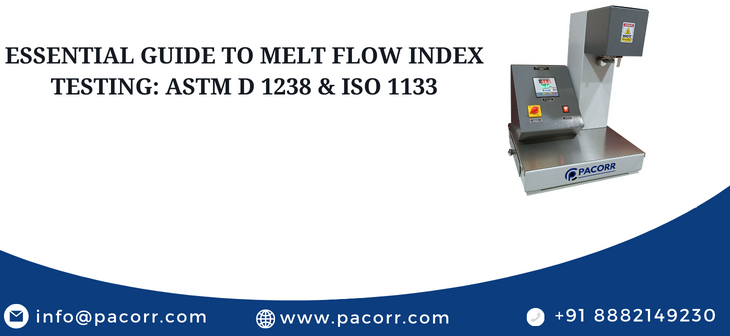
Melt Flow Index (MFI) tester play a pivotal role in assessing the flow characteristics of plastic materials under controlled conditions. This comprehensive guide delves into the technicalities of MFI testers, their importance in maintaining product quality, and how they comply with industry standards ASTM D 1238 and ISO 1133, with a particular focus on the instruments provided by Pacorr.
Understanding Melt Flow Index Testers
Melt Flow Index testers, also known as Melt Flow testers, are essential in measuring the flow rates of thermoplastic polymers. These instruments calculate how much polymer can flow in ten minutes through a specific-sized die when subjected to a defined force at a set temperature. The result, the Melt Flow Rate (MFR), is a critical parameter used by industries to characterize material properties.
The Importance of Melt Flow Index
The MFR is not just a number—it's an indicator of material behavior in various manufacturing processes and can influence the following:
- Consistency and Quality Control: High repeatability in MFR measurements ensures that each batch of plastic produced adheres to stringent quality standards.
- Material Selection and Design: Engineers rely on accurate MFR data to select materials that meet the specific flow requirements necessary for creating complex and durable products.
- Processing Parameters: Adjustments in the production process, such as temperature and load, often depend on MFR values to enhance efficiency and minimize defects.
ASTM D 1238 and ISO 1133: A Closer Look
The significance of adhering to ASTM D 1238 and ISO 1133 standards in the use of MFI testers cannot be overstated. These standards not only facilitate uniformity in testing methods across different geographic locations but also ensure that the test results are globally comparable and reliable.
- ASTM D 1238: Predominantly used in the United States, it details the conditions under which the melt flow rate should be measured, including specific requirements for the dimensions of the die and the weight applied to the material.
- ISO 1133: Recognized internationally, this standard provides guidelines for the determination of both melt flow rate and melt volume rate, accommodating a broader range of materials and testing scenarios.
Pacorr’s Advanced Melt Flow Index Testers
Pacorr stands out in the testing equipment market with its cutting-edge Melt Flow Index testers that are designed to meet both ASTM D 1238 and ISO 1133 standards. Their testers are known for:
- High Precision: Ensuring accurate and repeatable results, critical for quality control and R&D.
- Ease of Use: Designed with the user in mind, Pacorr’s testers feature intuitive controls and automated procedures that simplify the testing process.
- Durability and Reliability: Built to last, these testers can withstand the rigors of both laboratory and production environments.
Step-by-Step Usage of MFI Testers
Operating an MFI tester involves several key steps:
- Sample Preparation: Ensure the polymer is uniformly cut and dried to prevent variability in results.
- Loading the Material: Accurately fill the barrel with the polymer to avoid air pockets, which can affect the flow.
- Applying the Test Conditions: Set the temperature and load according to the standard requirements for the specific polymer being tested.
- Measuring and Recording: Collect the extruded polymer and accurately measure the weight to calculate the MFR.
Wrapping Up: The Role of MFI Testers in Industry
The insights provided by Melt Flow Index testing are invaluable across various stages of polymer manufacturing—from material selection through to the final product testing. Pacorr’s commitment to excellence in the design and manufacturing of MFI testers ensures that industries can rely on accurate, consistent, and globally recognized testing protocols to maintain high standards of product quality.
By embracing these sophisticated testing tools, companies are better equipped to innovate and excel in the competitive field of polymer production, driving forward advancements in product development and manufacturing efficiency.

